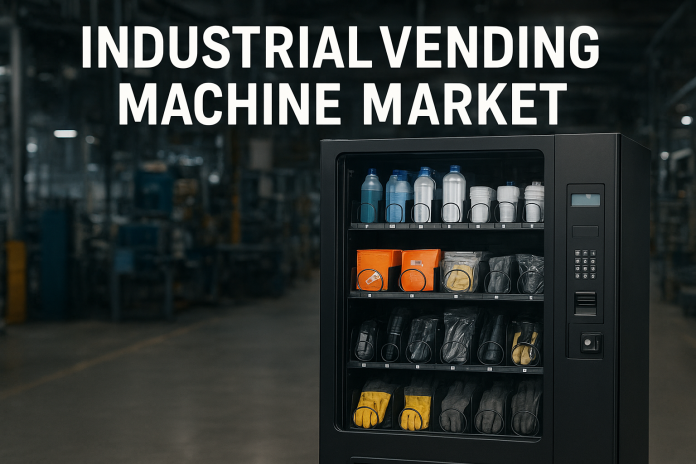In today’s fast-paced industrial environment, efficiency, cost management, and inventory control are paramount. Industrial vending machines have emerged as a game-changer, offering automated solutions to streamline operations, reduce waste, and ensure timely access to critical tools and consumables. By integrating technology into inventory management, these machines are redefining how industries manage their resources, improve productivity, and enhance worker safety.
The Industrial Vending Machine Market size was valued at USD 2.25 Billion in 2023 and is projected to reach USD 5.27 Billion by 2032, growing at a CAGR of 9.92% over the forecast period of 2024-2032. This impressive growth highlights the increasing adoption of automated dispensing solutions across various sectors, including manufacturing, automotive, healthcare, and logistics. The demand is driven by the need for operational efficiency, real-time tracking of inventory, and reduction in human errors associated with manual stock management.
Key Drivers Fueling Industrial Vending Machine Adoption
The growing complexity of industrial operations requires precise inventory management to prevent production downtime. Industrial vending machines provide a seamless solution, allowing companies to control access to tools, safety gear, and consumables while keeping detailed usage records. By reducing material loss and improving accountability, these machines help businesses save costs and ensure uninterrupted operations.
Additionally, the rise of Industry 4.0 technologies, including IoT-enabled devices, cloud computing, and data analytics, has significantly enhanced the capabilities of industrial vending machines. Modern machines not only dispense items but also provide real-time data on inventory levels, usage patterns, and employee access. This level of insight empowers managers to optimize inventory, forecast demand accurately, and make informed decisions.
Segmentation Analysis: Tailored Solutions for Diverse Industries
The Industrial Vending Machine Market is broadly segmented based on product type, end-use industry, and deployment mode. Product types include automated tool dispensers, safety and PPE vending machines, and consumable vending machines. Each type caters to specific operational requirements, offering customized solutions for industrial needs.
By end-use, manufacturing remains the largest adopter of vending solutions due to high consumption of tools and safety equipment. Automotive and aerospace industries are also witnessing growing adoption, driven by the need to maintain precision and operational continuity. Healthcare and pharmaceutical sectors are leveraging vending machines for controlled dispensing of medical consumables, ensuring compliance and minimizing wastage.
Deployment modes are categorized into on-premise and cloud-enabled systems. On-premise systems are preferred for localized operations, whereas cloud-enabled machines provide centralized control and data access, making them ideal for multi-location industrial setups. The increasing popularity of cloud-enabled vending solutions is fueling market growth as businesses seek smarter, connected inventory systems.
Regional Analysis: Global Expansion of Industrial Vending Solutions
North America dominates the industrial vending machine landscape due to its mature industrial base, early technology adoption, and focus on operational efficiency. Europe follows closely, driven by stringent safety regulations and growing automation trends in manufacturing and logistics.
The Asia Pacific region is expected to witness the fastest growth during the forecast period. Rapid industrialization, expanding manufacturing hubs, and increasing labor costs are prompting businesses to adopt automated vending systems. Countries such as China, India, and Japan are leading this growth, with local and international players investing heavily to capture market opportunities.
Competitive Landscape: Innovation and Strategic Expansion
The industrial vending machine market is highly competitive, with key players focusing on innovation, strategic partnerships, and geographic expansion. Companies are developing advanced machines with IoT integration, AI-driven analytics, and enhanced security features to differentiate themselves. Strategic collaborations with industrial distributors and OEMs help companies expand their market reach and cater to diverse industries.
Moreover, service offerings such as maintenance, remote monitoring, and customized reporting solutions provide added value, encouraging customer loyalty and long-term contracts. The competitive landscape continues to evolve as new entrants bring innovative solutions to address the growing demand for automation and operational efficiency.
Future Outlook: Efficiency-Driven Growth
As industries continue to embrace digital transformation, the adoption of industrial vending machines is expected to accelerate. Businesses are recognizing the benefits of automation in reducing operational costs, improving inventory accuracy, and enhancing workforce productivity. The convergence of vending technology with analytics and connectivity solutions will drive further innovations, shaping the future of industrial resource management.
In conclusion, the Industrial Vending Machine Market is poised for robust growth, reflecting a global shift towards smarter, automated industrial operations. With advancements in technology and increasing demand for efficiency, these machines are no longer optional but essential for modern industrial environments. Companies that leverage these solutions are well-positioned to achieve cost savings, operational efficiency, and enhanced accountability.
FAQs
1. What is the CAGR of the Industrial Vending Machine Market?
The market is expected to grow at a CAGR of 9.92% from 2024 to 2032.
2. What is the forecast for the Industrial Vending Machine Market by 2032?
The market size is projected to reach USD 5.27 Billion by 2032.
3. Which region is expected to witness the highest growth?
The Asia Pacific region is anticipated to experience the fastest growth due to rapid industrialization and increasing automation adoption.


